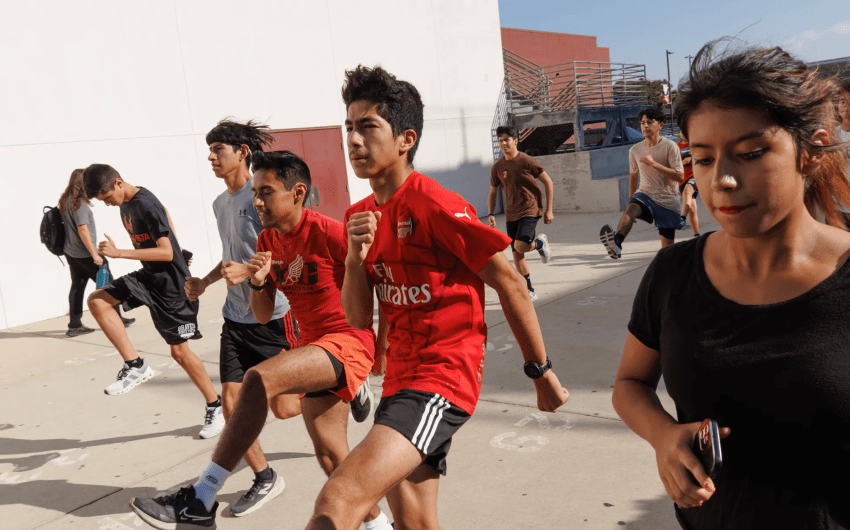Santa Barbara High Schoolers Are Speaking Up About What’s Bringing Them Down
Student-Led Clubs Give Teens Stigma-Free Space to Discuss Mental Health, Share Experiences, and Advocate for Resources

Ever since the pandemic, teenagers are finding themselves in the center of the United States’ self-diagnosed mental health crisis. The stereotypical angst and cynicism associated with their age group is becoming a real problem — a recent study from UC Santa Barbara, for example, found that teens’ social well-being plummeted during the pandemic and has not recovered.
“Even adults, I mean, our brains are fully developed, and we were stressed,” said Rocio Pacheco Garcia, the high-school program manager for the Santa Barbara Mental Wellness Center. “So I can’t even imagine what it was like for them.”
To be fair, a modern teenager’s mental state is up against multiple opponents, including increased screen time — which has been linked to higher rates of depression and anxiety — alongside the typical stress associated with the lovely time of adolescence.

“It’s a delicate dance,” said Mark Alvarado, an outreach worker for the Santa Barbara Unified School District. “Hormones are kicking in, and when there’s a mental health crisis, that just makes everything more complicated. Sometimes kids become introverted, or they don’t have the skills to cope in a school environment.”
But as the conversation gets louder, with teens themselves turning up the volume, schools and organizations are doing more to address mental health on campus.
At Dos Pueblos, San Marcos, and Santa Barbara high schools, the Santa Barbara Mental Wellness Center is promoting mental health caretaking through Wellness Connection Councils, encouraging students to speak up about what brings them down.
Established in 2020, with hundreds of students from six county high schools participating every year, these student-led clubs are places to discuss mental health, share experiences, and advocate for resources on their campuses and in their communities — without stigma.
“It’s really a place for the student voice to be heard,” Pacheco said.

Each school tailors its activities to students’ needs, such as mindfulness exercises and therapy dogs to address burnout at Santa Barbara High, a student-made PSA to raise awareness at Dos Pueblos, or drum circles for anxiety relief at San Marcos. Each school has been coordinating their own campaign for Mental Health Awareness Month this May.
“People can find [mental health] hard to talk about in school,” said San Marcos senior Alexis Fell. “And so we hold an open safe space, where anyone can come out and is welcome.”
Fell, a club leader at her school, said she is passionate about destigmatizing mental health issues, having witnessed the toll of isolation and academic pressure on her peers.
“You need resources, and you deserve support, no matter the severity of what you’re feeling,” she added, especially following tragic incidents of suicide, which left a mark on the San Marcos community over the last year. “You never really know from the outside how these things really affect everyone.”
For Mental Health Awareness Month, the club spread positivity with chalk notes in the student parking lot, “to brighten people’s days during all the end-of-year stress,” Fell said, and plans to promote awareness and resources through tabling at the month’s end.
Additionally, San Marcos is currently redesigning its wellness center to “better respond” to students’ mental health needs and destigmatize asking for help by moving services “away from the front office to a comfortable, intentionally designed space,” said Principal Dare Holdren.
Teachers and staff often make up the front lines when it comes to recognizing and addressing student mental health challenges. In his time working for the school district, Alvarado has learned that, often, but not always, mental health challenges stem from a “lack of love” or understanding at home.
“They want to feel good,” he continued. “For little kids, that could be candy; they get older, and that’s hot Takis; and they get older, and that could be drugs, or alcohol, or sex.”

For kids that can’t “fill the gap,” and they often cannot when relying on these addictions, he said, that’s “when hopelessness sets in and tragic events unfold. Children get lost in the shuffle.”
In Santa Barbara in particular, large wealth disparities between students can exacerbate the problem.
“Suicide doesn’t discriminate, but when you have such a huge disparity, kids kind of get caught in the middle of that; there’s not a cohesive community feeling sometimes,” he said.
“Especially kids who are low-income. It’s challenging for young people living in density, when there’s opulence less than five miles away. And kids do achieve, they overcome, but in terms of mental health, it’s challenging to have that right in your face.”
Counselors and other trusted adults can help by “being culturally proficient,” intervening when necessary, and, overall, encouraging teens to build a sense of identity and confidence, he suggested. Even placing struggling students in classrooms with “thriving” peers who come from the same background can have a positive impact.
“You give them an acknowledgment of self, build their confidence, and attendance improves, grades improve,” Alvarado continued. “It’s all focused around making a difference in a kid’s life — sometimes we’re just planting the seeds, but with the intention of making a difference.”
Through the Wellness Connection Councils, high schoolers themselves are helping plant those seeds. At Dos Pueblos this month, they plan to raise awareness by, in part, creating a “Spotify Wall,” where students can post motivational songs to feel more connected and less stressed as the school year closes. And they plan to use their new campus wellness center — set to open soon — as a hub for their activities.
“Often, students just get so burnt out from school,” said Dos Pueblos club president Nicole Barger. “We neglect other factors, whether that’s eating healthy or getting exercise, or sleeping is a big one. So mental health is just as important as physical health, and usually, they end up mixing. That’s why creating an environment where students can thrive in school and feel safe and supported is so important.”
Barger is looking forward to Dos Pueblos becoming the first host of a new teen-focused Mental Health First Aid class, aiming to equip students to recognize and respond to peers’ mental health challenges, such as eating disorders or self-harm. That adds to the Wellness Center’s Mental Health Matters curriculum, which educates 6th-graders and high schoolers across Santa Barbara County on mental health topics — knowledge, attitudes, and behaviors — to address stigma and promote understanding, coping skills, and access to resources.
“Teens are often the first to notice when a friend is going through a mental health challenge,” said Pacheco. “It’s important that they know how to respond appropriately.”
To learn more about Wellness Connection, visit here. Teens and parents in Santa Barbara County can also seek mental health resources from the County’s Department of Behavioral Wellness.
Premier Events
Thu, Oct 03
5:00 PM
Santa Barbara
UNA Santa Barbara 8th Annual Peace Prize Award
Fri, Sep 27
5:00 PM
Santa Barbara
Doublewide Kings at Elings Park’s “Local Vibes”
Fri, Sep 27
7:30 PM
Santa Barbara
Martin Media Presents: Alfred Robles
Fri, Sep 27
8:00 PM
Santa Barbara
Colonel Angus (AC/DC Tribute)
Sat, Sep 28
10:00 AM
Santa Barbara
Alice Keck Park Butterfly Garden Celebration
Sat, Sep 28
10:00 AM
Goleta
FREE Microchipping Clinic & ASAP Adoption Event!
Sat, Sep 28
2:00 PM
Santa Barbara
S.B. Home Movies at the Granada: “Holes”
Sat, Sep 28
8:00 PM
Santa Barbara
Lucinda Williams & Mike Campbell & The Dirty Knobs
Sun, Sep 29
10:00 AM
Goleta
Goleta Lemon Festival
Wed, Oct 02
12:00 PM
Santa Barbara
“Project Fiesta!” Celebrates 100 Years of Fiesta
Wed, Oct 09
5:30 PM
Santa Barbara
Sewing and Mending Club
Thu, Oct 03 5:00 PM
Santa Barbara
UNA Santa Barbara 8th Annual Peace Prize Award
Fri, Sep 27 5:00 PM
Santa Barbara
Doublewide Kings at Elings Park’s “Local Vibes”
Fri, Sep 27 7:30 PM
Santa Barbara
Martin Media Presents: Alfred Robles
Fri, Sep 27 8:00 PM
Santa Barbara
Colonel Angus (AC/DC Tribute)
Sat, Sep 28 10:00 AM
Santa Barbara
Alice Keck Park Butterfly Garden Celebration
Sat, Sep 28 10:00 AM
Goleta
FREE Microchipping Clinic & ASAP Adoption Event!
Sat, Sep 28 2:00 PM
Santa Barbara
S.B. Home Movies at the Granada: “Holes”
Sat, Sep 28 8:00 PM
Santa Barbara
Lucinda Williams & Mike Campbell & The Dirty Knobs
Sun, Sep 29 10:00 AM
Goleta
Goleta Lemon Festival
Wed, Oct 02 12:00 PM
Santa Barbara
“Project Fiesta!” Celebrates 100 Years of Fiesta
Wed, Oct 09 5:30 PM
Santa Barbara

























You must be logged in to post a comment.